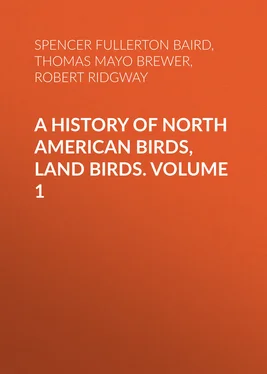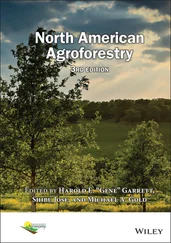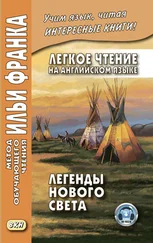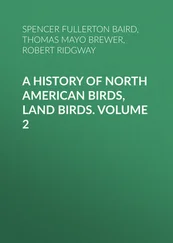Robert Ridgway - A History of North American Birds, Land Birds. Volume 1
Здесь есть возможность читать онлайн «Robert Ridgway - A History of North American Birds, Land Birds. Volume 1» — ознакомительный отрывок электронной книги совершенно бесплатно, а после прочтения отрывка купить полную версию. В некоторых случаях можно слушать аудио, скачать через торрент в формате fb2 и присутствует краткое содержание. Жанр: foreign_antique, Биология, foreign_edu, на английском языке. Описание произведения, (предисловие) а так же отзывы посетителей доступны на портале библиотеки ЛибКат.
- Название:A History of North American Birds, Land Birds. Volume 1
- Автор:
- Жанр:
- Год:неизвестен
- ISBN:нет данных
- Рейтинг книги:3 / 5. Голосов: 1
-
Избранное:Добавить в избранное
- Отзывы:
-
Ваша оценка:
- 60
- 1
- 2
- 3
- 4
- 5
A History of North American Birds, Land Birds. Volume 1: краткое содержание, описание и аннотация
Предлагаем к чтению аннотацию, описание, краткое содержание или предисловие (зависит от того, что написал сам автор книги «A History of North American Birds, Land Birds. Volume 1»). Если вы не нашли необходимую информацию о книге — напишите в комментариях, мы постараемся отыскать её.
A History of North American Birds, Land Birds. Volume 1 — читать онлайн ознакомительный отрывок
Ниже представлен текст книги, разбитый по страницам. Система сохранения места последней прочитанной страницы, позволяет с удобством читать онлайн бесплатно книгу «A History of North American Birds, Land Birds. Volume 1», без необходимости каждый раз заново искать на чём Вы остановились. Поставьте закладку, и сможете в любой момент перейти на страницу, на которой закончили чтение.
Интервал:
Закладка:
Subfamily SITTINÆ
The characters of the Sittinæ are expressed with sufficient detail on page 86. The section is represented in America by a single genus, confined mainly to the northern portion.
Sitta , Linnæus, Syst. Nat. 1735. (Agassiz.)
Sitta carolinensis.
1761♀
Gen. Char. Bill subulate, acutely pointed, compressed, about as long as the head; culmen and commissure nearly straight; gonys convex and ascending; nostrils covered by a tuft of bristles directed forward. Tarsi stout, scutellate, about equal to the middle toe, much shorter than the hinder, the claw of which is half the total length. Outer lateral toe much longer than inner, and nearly equal to the middle. Tail very short, broad, and nearly even; the feathers soft and truncate. Wings reaching nearly to the end of the tail, long and acute, the first primary one third of (or less) the third, or longest. Iris brown. Nest in holes of trees. Eggs white, spotted with reddish.
The North American species may be arranged as follows:—
A.Crown black.
S. carolinensis.Belly white; no black stripe through eye.
Bill, .70 long, .17 deep. Black spots on tertials sharply defined. Hab. Eastern Province North America … var. carolinensis .
Bill, .80 long, .14 deep. Black spots on tertials obsolete. Hab. Middle and Western Province United States, south to Cordova, Mexico … var. aculeata .
S. canadensis.Belly brownish-rusty. A black stripe through eye. Hab. Whole of North America.
B.Crown not black.
S. pusilla.Crown light hair-brown; hind toe much longer than the middle one. Hab. South Atlantic and Gulf States.
S. pygmæa.Crown greenish-plumbeous; hind toe about equal to middle one. Hab. Western and Middle Province United States, south to Xalapa.
Sitta europæa , var. γ, carolinensis , Gm. S. N. I, 1788, 440. Sitta carolinensis , Lath. Ind. Orn. I, 1790, 262; also of all other American writers.—Reichenbach, Handbuch, Abh. II,, 1853, 153, tab. dxiii, figs. 3563, 3564.—Baird, Birds N. Am. 1858, 374, pl. xxxiii, fig. 4; Review, 86.—Max. Cab. Jour. VI, 1858, 106. Sitta melanocephala , Vieill. Gal. I, 1834, 171, pl. clxxi.
Other figures: Wilson, Am. Orn. I, pl. ii, fig. 3.—Aud. Orn. Biog. II, pl. clii.—Ib. B. A. IV, pl. ccxlvii.
PLATE VIII.
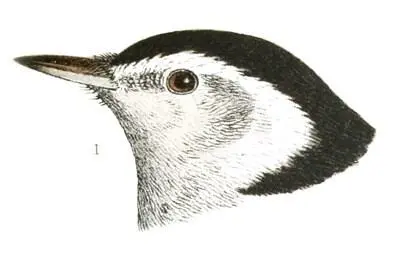
1. Sitta carolinensis, Gm. ♂ Pa., 59324.
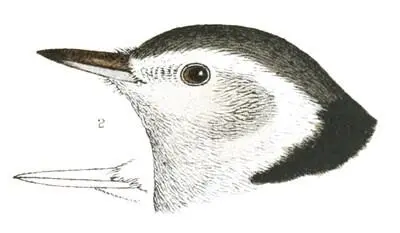
2. Sitta carolinensis, Gm. ♀
3. Salpinctes obsoletus, Say. Cal., 7157.
4. Catherpes mexicanus, Sw., var. Mex., 53425.
5. Campylorhynchus brunneicapillus, Lafr. ♂ Cal., 7149
6. Campylorhynchus affinis, Xantus . ♂ Cape St. Lucas, 12965
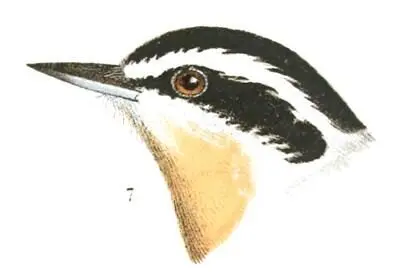
7. Sitta canadensis, Linn. ♂ Pa., 818
8. Sitta canadensis, Linn. ♀ Pa., 2073.
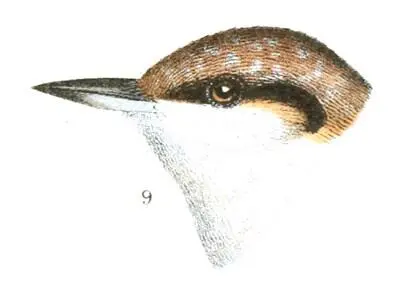
9. Sitta pusilla, Lath. Ga., 1925.
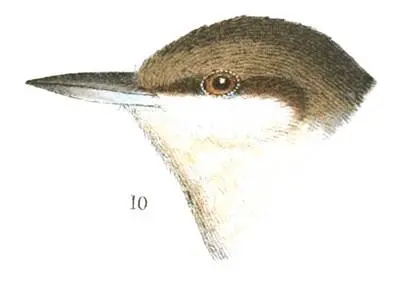
10. Sitta pygmæa, Vig. Cal., 3342.
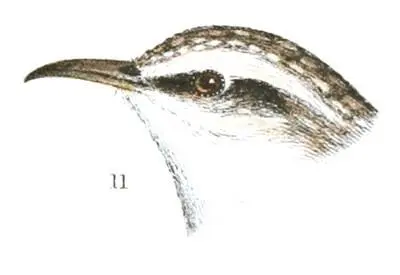
11. Certhia americana, Bon. ♂ Pa., 827.
Sp. Char. Above ashy-blue. Top of head and neck black. Under parts and sides of head to a short distance above the eye white. Under tail-coverts and tibial feathers brown; concealed primaries white. Bill stout. Female with black of head glossed with ashy. Length about 6 inches; wing about 3.75.
Hab. United States and British Provinces; west to the Valley of the Missouri.
Sitta aculeata.
Habits. The common White-bellied Nuthatch has an extended distribution throughout nearly the whole of Eastern North America, from the Atlantic to the Rocky Mountains. West of the great central plains it is replaced by the var. aculeata . It has not been met with, so far as I am aware, farther north than Nova Scotia. It is a resident of Eastern Maine, and is quite common in the southern and western portions of the same State. In Massachusetts it is rather common than abundant, and more plentiful in the western than in the eastern portions of that State.
The habits of this and the other species of Nuthatches partake somewhat of those of the smaller Woodpeckers and of the Titmice. Without the noisy and restless activity of the latter, they seek their food in a similar manner, and not unfrequently do so in their company, moving up or down the trunks and over or under the branches of trees, searching every crack and crevice of the bark for insects, larvæ, or eggs. Like the Woodpeckers, they dig industriously into decayed branches for the hidden grub, and like both Woodpeckers and Chickadees they industriously excavate for themselves a place for their nests in the decayed trunks of forest trees. Their nest, however, is usually at a greater elevation, often some twenty or thirty feet from the ground. The European Nuthatch is said to plaster up the entrance to its nest, to contract its opening and lessen the dangers of unfriendly intrusion. This habit has never been observed in any of the American species.
All our ornithological writers have noticed the assiduities of the male bird to his sitting mate, and the attention with which he supplies her with food. He keeps ever in the vicinity of the nest, calls her from time to time to come to the mouth of the hole to take her food, or else to receive his endearments and caresses, and at the approach of danger fearlessly intervenes to warn her of it. When feeding together, the male bird keeps up his peculiar nasal cry of hŏnk-hŏnk , repeating it from time to time, as he moves around the trunk or over the branches.
Their favorite food is insects, in every condition. With this, when abundant, they seem content, and rarely wander from their accustomed woods in summer. In winter, when snow or ice covers the branches or closes against them the trunks of trees, they seek the dwellings and out-houses for their necessary food, and will even alight on the ground in quest of seeds. In searching for food among the trees, they move as readily with their heads downward as in any other position. Their motion is a uniform and steady progression, somewhat in the manner of a mouse, but never, like the Woodpecker, by occasional hops.
The European species collect and store away the fruit of the hazel and other nut-bearing trees. Our bird has been supposed to do the same thing, but this is by no means an indisputable fact.
In some parts of the country absurd prejudices prevail against these interesting little birds. They are indiscriminately confounded with the smaller Woodpeckers, called, with them, Sap-Suckers, and because in the spring and fall they frequent old orchards are most unwisely, as well as unjustly, persecuted. They are among the most active and serviceable of the fruit-grower’s benefactors. His worst enemies are their favorite food. It is to be hoped that soon a better-informed public opinion will prevail, cherishing and protecting, rather than seeking to destroy, this useful, affectionate, and attractive species.
Читать дальшеИнтервал:
Закладка:
Похожие книги на «A History of North American Birds, Land Birds. Volume 1»
Представляем Вашему вниманию похожие книги на «A History of North American Birds, Land Birds. Volume 1» списком для выбора. Мы отобрали схожую по названию и смыслу литературу в надежде предоставить читателям больше вариантов отыскать новые, интересные, ещё непрочитанные произведения.
Обсуждение, отзывы о книге «A History of North American Birds, Land Birds. Volume 1» и просто собственные мнения читателей. Оставьте ваши комментарии, напишите, что Вы думаете о произведении, его смысле или главных героях. Укажите что конкретно понравилось, а что нет, и почему Вы так считаете.
